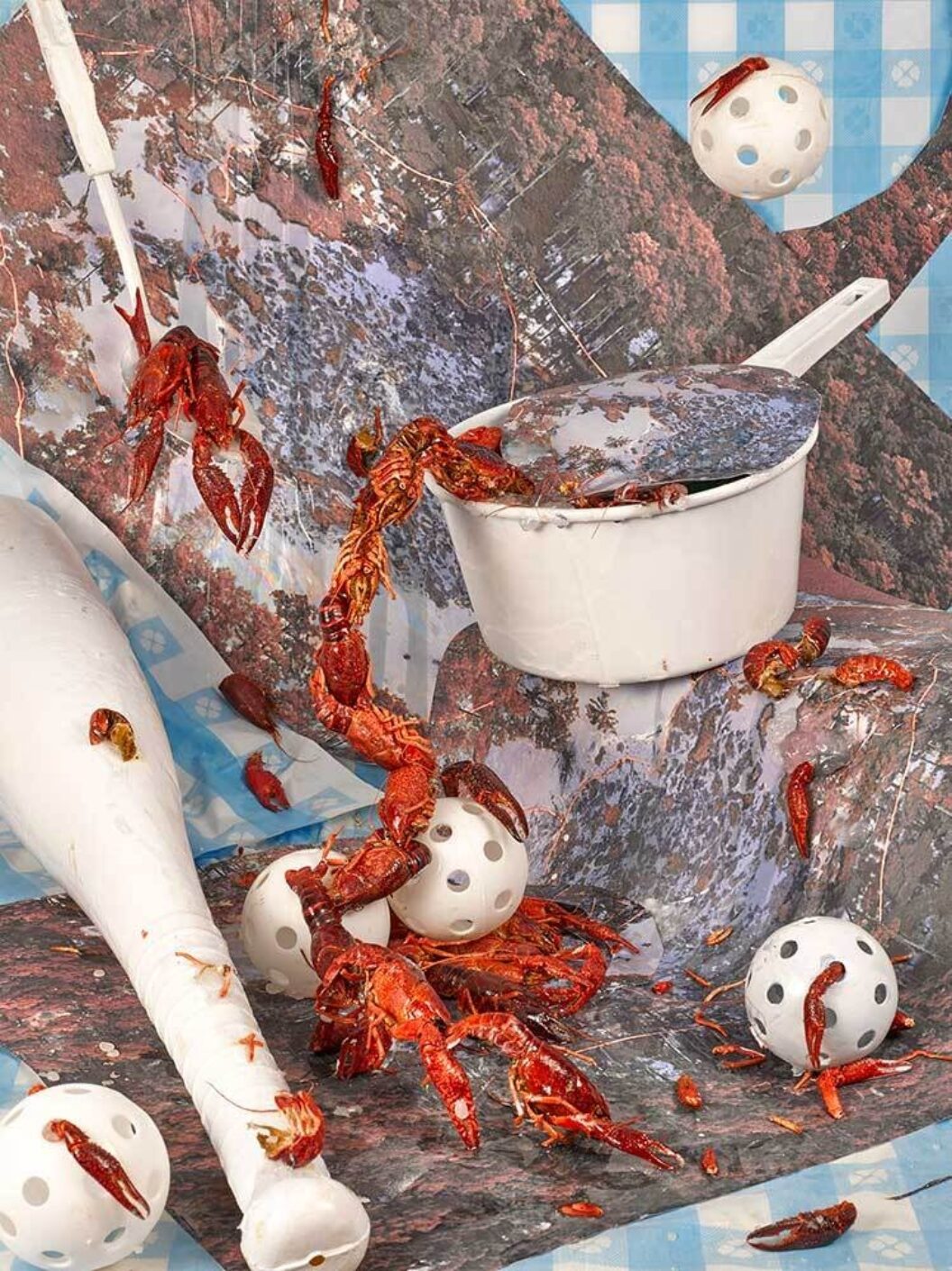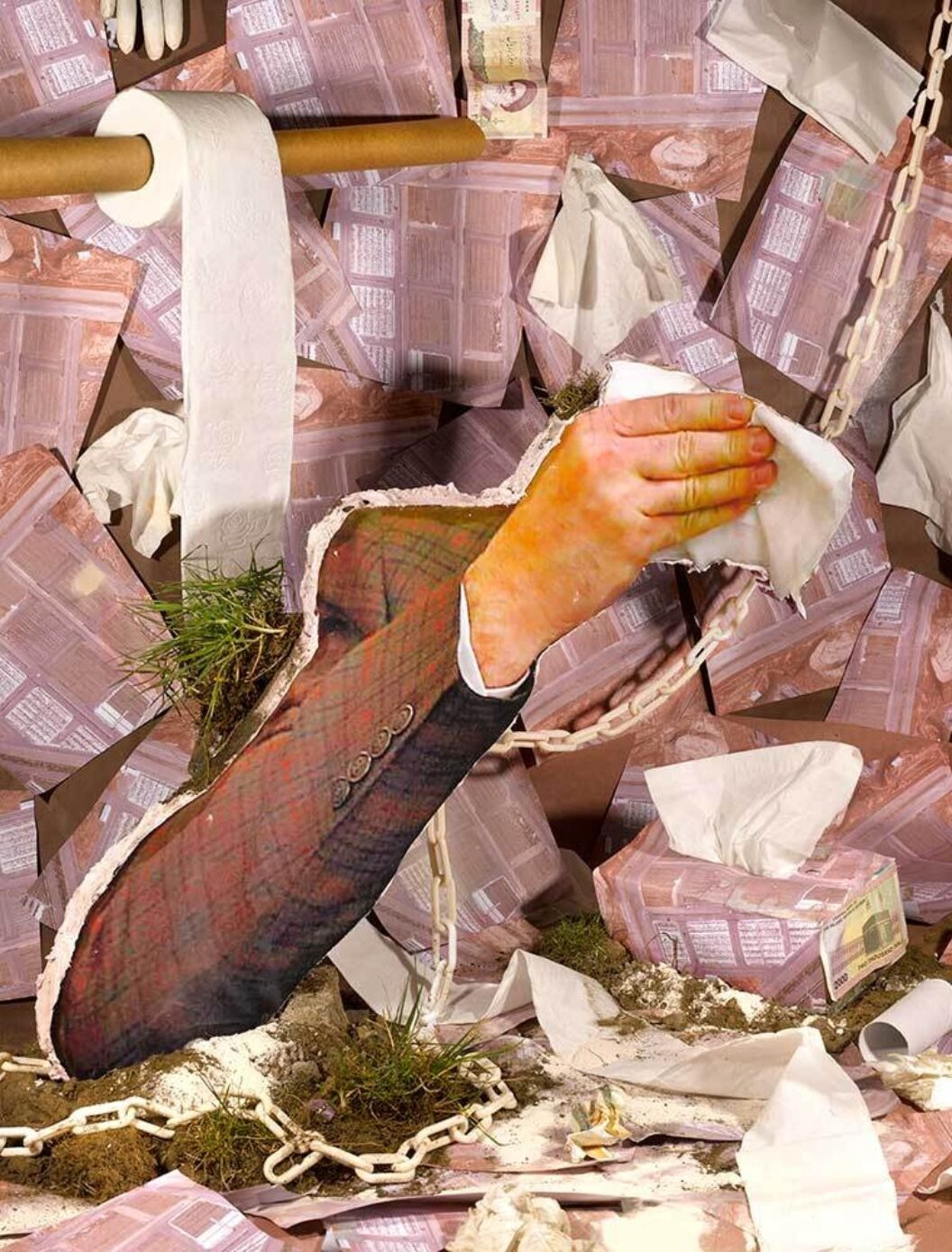Critique and Care: Sheida Soleimani Interviewed by Cassie Packard
Photomontages that expose power and brutality.

Sheida Soleimani’s collapsed images teem with signification. The Iranian American artist, who lives and works in Providence, Rhode Island, constructs elaborate tableaux that incorporate an array of symbolic objects (bubble gum, toilet paper) and found source imagery (aerial views of oil fields, crooked politicians’ gesturing hands). Compressed into two-dimensional photographs with the seductive gloss of an internet aesthetic, these scenes deliver searing critiques of global systems of exploitation and extraction that irreparably harm environments and their inhabitants. As Soleimani’s work looks outward at the global petroleum industry or political corruption in the United States and Iran, it also encourages viewers to turn inward, confronting the assumptions and blind spots that they bring to her images. I spoke with Soleimani about putting evaders of justice in the aesthetic hot seat, making activist art outside of the sentimentalizing traditions of the genre, and rehabilitating wild birds. —Cassie Packard
Cassie Packard
Can you talk about your longstanding relationship with political activism?
Sheida Soleimani
I was raised a Marxist atheist in the Bible Belt Midwest by Persian political refugees who escaped oppression during the ’79 Iranian Revolution for their pro-democratic activism. I know that sentence is a lot, but it’s a sentence I’ve wound up parsing for much of my life. I am really lucky to be able to process this jarring collection of identities, cultures, and environments. By virtue of refusing to make nice with their neighbors, and in many ways refusing to assimilate, my parents introduced me to principles and beliefs that I aspire to in my life and my work: speaking frankly to power, rallying around difference, and confronting ignorance and misrecognition. One Halloween during the Iraq War, for example, my dad briefly became notorious in our cornfield suburb for constructing a scene involving George W. Bush in a casket. Activism—as resistance, refusal, critique but also repair, care, compassion—is something I cannot do without.
I carry this activist impulse into my work. For inspiration, I frequently turn to propaganda posters—OSPAAL in Cuba, Emory Douglas’s Black Panther Party aesthetic, or the Iranian Poster Arts collection at the University of Chicago—to think about how to use humor and the grotesque to confront corruption, oppression, and other modes of marginalization.
Finding clever ways of seducing viewers to engage with a work is something I think is especially important in the art world, which is so profit-driven and so prone to turning a blind eye to entrenched inequality. In sweeping away the West’s blinkered, Orientalist view of the Middle East and centering the spectator’s gaze on actual ongoing drivers of injustice and inequality, like the global petroleum industry, I seek to put in the aesthetic hot seat those who continually evade the scales of justice. At the same time—and this is getting back to repair and care—I am just as concerned with giving the marginalized visibility and agency within my work.

CP
Does your artmaking always occur in relation to that activist impulse?
SS
Absolutely. I’m not ever going to be interested in making work without political content or work where the political is subordinated to the aesthetic. What I am interested in doing is building tableaux of objects and images that are charged. While a work’s charge is felt first and processed later, it’s precisely that charge that leads a viewer to engage with the work. And if that work is not simply a pretty picture but actually has content and leads the viewer down a path toward recognizing and acknowledging the violent histories linking the economic and the political, then it gains an entirely new charge that is no longer simply emotional or subliminal but now conscious.
If anger often drives me in my artmaking, I also spend a lot of time on care. As a wildlife rehabilitator, I take in north of four hundred to five hundred birds for four months of the year and spend five to six hours with them each day. I’ve received concussed woodpeckers, grackle nestlings with crooked beaks, stunned owls hit by cars, and thousands of birds that I’ve had to humanely euthanize. To go back to the question before this, I’d say that this is not a response to what I explicitly learned about activism growing up, but rather flowed from seeing my parents have to deal with the exhaustion, fatigue, and trauma of leaving Iran and moving to a Midwest that wasn’t particularly welcoming to a family with an Islamic last name. I wouldn’t say my animal work is not “activist,” for to do so would be to reproduce the West’s ludicrously artificial division between history and nature which has been responsible for so much environmental devastation and which I see daily when someone drops off a dead or dying bird on my doorstep.
CP
Your highly constructed photographs read as more “made” than “taken.” I’m curious about your process and what drew you to photographing built tableaux in the first place.
SS
Because photography has so often been used as an instrument for creating and imposing violent divisions between humans on the bases of race, gender, class, as well as between humans, animals, and nature, it’s crucial to me to devise an ethical photographic practice that uses the camera differently. “Taking” a photograph can be an oppressive, non-consensual act. What does a consensual image consist of? For the subject? For the viewer? In considering these questions, I arrived at the idea of building tableaux, since building and photographing theatrical sets is free from some—not all—of these issues of agency and consent. If the tableau affords me added control, allowing me to create an assemblage of symbolic objects, source imagery, and, say, a political effigy, this collaging and arranging becomes the key ethical act. My goal almost always is to induce in viewers self-examination so that they can consider how they see my image—according to which biases, blind spots, and societal conditioning—while also reconsidering how they’ve seen similar things depicted in the media.

CP
To what extent are you actively engaging with histories of photomontage or photocollage? I’m wondering in part because of the medium’s established links to sociopolitical critique.
SS
I look at Dada collage quite a bit. I find Hannah Höch’s Frankensteinish cyborgs especially compelling, particularly because of her use of cutting, splicing, and re-situating images to produce distorted and grotesque figures during a time of massive upheaval in Weimar Germany. In some ways, cutting is a violent act, so when I cut and resituate images I try to situate this act in some sort of relationship to a photograph’s traumatic content, if that’s what I’m dealing with.
CP
Technically and conceptually, “flattening” seems central to your work. Can you tell me about that strategy and whether you see a violence in it?
SS
It’s absolutely violent, but at the same time it doesn’t appear that way. This isn’t exactly a paradox so much as a trick. At first, flattening the image confuses many people when they see my works, an effect I produce by using a high aperture like f22 to dehierarchize the depth of field by making everything in focus, visible, and of equal value. By collapsing foreground and background, viewers are made to reckon differently with what they’re seeing before they’re able to process the violent side of flattening, which is to say that this effect is not merely an advertising trick meant to lure them in but also a representation of what happens to individuals—both citizens and the stateless—at the hands of corrupt, autocratic regimes.
CP
In CRUDES (2018–19) you depict objects made with petroleum byproducts, like basketballs and bubble gum, in pretty colors with commercial lighting. As I unpacked the content of the images—environmental degradation caused by the crude-oil industry—their superficial allure made me confront my own complicity as a consumer. I’m curious about the intent behind packaging this critique in an advertorial vernacular.
SS
We’re accustomed to digesting images of pain and trauma through certain genres, like the sentimental, which often represent suffering humans to induce pity and catalyze action. These genres so often miss the mark and even reinforce some of the problems they aim to fix. In CRUDES, I’m looking at specific crude-oil blends and the human and environmental harm in the regions in which they’re produced. Needless to say, the content isn’t pleasant, and I thought a lot about billboards and food photography when considering how to make this painful content both accessible and unsettling.
So, we’re more than complicit in the petroleum industry, since we fail to realize how much we participate in this economy and because it is nearly or seemingly inescapable at this point. Crude-oil byproducts make up so much of what’s around us: plastics, rubber, polyester, the shoes you wear, the gloves you use for yard work. It’s all made from petroleum, and participation in this economy drives further extraction and pollution. A lot of environmental work is very moralizing and sentimentalizing in the humanitarian sense, but I think that new genres need to serve an educational function. At the very least, I want these “crude” dystopian subverted adverts to get people to become aware of their place within a consumer economy.
